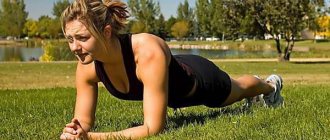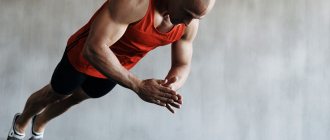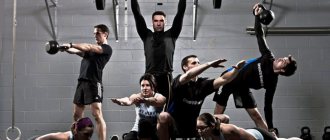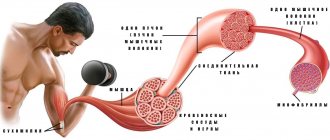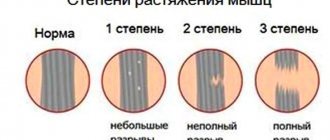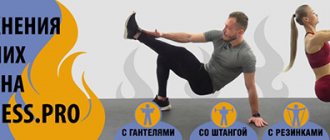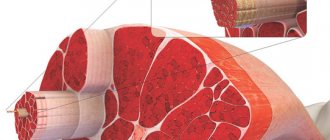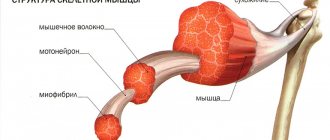Accustoming muscles to loads. Adaptation of muscles to physical activity.
Changing the training program is not just a whim, it is a necessity, which is determined by the desire to constantly progress in:
Working weights;. Muscle mass;. Increased endurance and strength; Reducing the percentage of subcutaneous fat tissue.
As you know, muscle fibers are not thoughtless threads; they are a complex of contractile fibers that are constantly learning and adapting to the load. In order for them to grow, a person needs to throw them an “uncomfortable challenge”, i.e. one that they were not familiar with until now and which they could not cope with before. The idea of muscle overload is one of the most important principles of strength training.
When you start lifting new weights or performing new exercises, a time period is created when the muscles have not yet adapted to the new load. This is when the athlete’s body and his muscles actively respond to a change in load and strive in every possible way to grow and change their initial characteristics (be it strength, time under load, etc.
Once this period has passed, the muscles must be surprised and shocked again, otherwise you may hit a training plateau. Moreover, you need to surprise not necessarily with heavier weights, but also with a change in quantitative parameters (sets, repetitions, rest time) and also with the use of different Joe Weider principles (pyramid, supersets, etc.
Adaptation of muscles to load.
How quickly does the human body adapt to new stress? The human body is an amazing adaptive structure. It takes the brain about three weeks for something repeated every day to become a habit. Literally a couple of workouts are enough for the muscles, and they are already beginning to adapt to the new operating mode.
In particular, the most striking example of the speed of adaptation is when you started doing some new exercise (or came to the gym after a break) and the next morning you cannot move your arm or leg. However, 2-3 training sessions pass and the degree of pain subsides.
In other words, the first 2-4 weeks are the most stressful for the muscles and their most active changes occur, then (from 5 to 8 weeks) there is a phase of diminishing returns from training. Ultimately, at 9-12 weeks (see Fig. 1), the muscle stops responding well to the training program and needs to be given a different load than usual (adaptation occurs.
It should be kept in mind that the periods shown on the graph differ for athletes with different levels of training/genetics. These time periods are given for average gym/fitness room visitors.
Of course, for beginners (less than 1 year of training experience), the numbers will be higher, since muscle adaptation to the load proceeds more slowly (the brain-muscle connection is poorly developed) and adaptation lasts longer. In other words, the training program for beginners can be changed later by 5-10 weeks (i.e., plus the original numbers.
Experienced athletes who feel their body, they are familiar with special training techniques - pumping, supersets, etc., should look towards reducing the time before changing the training program. In particular, we can talk about figures of the order of 4-6 weeks within the framework of working with one training program.
In total, the approximate time (when the body/muscles still receive a good stimulus for growth) of training on one training program:
Beginners - 10-16 weeks, 2.5-4.5 months; More experienced - 8-11 weeks, 2-3 months; Advanced level - 4-6 weeks, 1-1.5 months. Many people, when thinking about changing a training program, take into account only the strength part of it, i.e. aerobic activity remains unchanged. However, it is also necessary to change it, because the body quickly adapts to cardiovascular activity and slows down fat burning.
Therefore, if the goal of training is drying, then both strength and aerobic load changes.
The body gets used to constant procedures on the treadmill and, having crossed a certain time limit (on average 1-2 months), begins to burn fewer calories than at the beginning.
The ideal solution that can speed up fat burning processes as much as possible is to quickly change the types of aerobic activity, in particular the following:
Week 1 to 3 - swimming; Week 4 to 7 – jumping rope;. Weeks 8 to 11: Sprint or walk. Why you don't need to change your training program often. Scientific point of view. Many people say that the training program needs to be changed frequently to surprise the muscles. This is wrong; it is physiologically impossible to shock the muscles due to their passivity.
In addition, few people know, but each exercise has its own learning curve, a system of neuromuscular adaptation. That is, the body adapts to each exercise in its own way, at different times. This “Training Period” can take from several weeks to several months depending on the complexity of the exercise and the qualifications of the athlete. To make it clearer what we are talking about, compare two exercises according to the degree of their mastery - biceps curls and deadlifts. The first one is learned quickly, the second one takes much longer.
So, according to the theory of neuromuscular adaptation, muscle growth at the initial stage (when the body gets acquainted with a new exercise) is minimal. A serious increase in muscle size occurs only after overcoming the Neural Changes Plateau.
I present to your attention the graph of the study “Neural Adaptation to Resistance Training” (Med Sci Sports Exerc. 1988), (see Fig. 2. It clearly shows that first (8-20 weeks) neural (neuromuscular) processes occur in the body changes and after this period more noticeable muscle growth is observed.
Researchers report:
“Increases in peak strength and the rate of its increase are associated with an increase in the nervous system’s ability to activate an increasing number of muscle fibers during exercise. Strength training can induce adaptive changes in the nervous system that allow exercisers to more fully activate the primary driving forces in certain movements and better coordinate the recruitment of all relevant muscles, thereby providing greater net force in a given direction of movement. The increase in strength occurs mainly due to improved neural adaptation skills, rather than due to muscle growth."
Conclusion: if you change exercises every 4-6 weeks, then the body will not have time to build a good brain-muscle connection that is involved in a particular exercise. During this time, the body will only be able to adjust this connection, and the athlete will already jump to another exercise (training program. To improve the neuromuscular connection, the training program should always include multi-joint exercises for each muscle group. In this case, the neuromuscular connection develops faster than if the training program included only single-joint movements.
Another very important point that requires additional explanation is...
Change your training program or increase weights? Human muscles are devoid of brains; in this regard, they are passive tissues. They just carry out commands sent from the central nervous system. Therefore, they cannot be deceived; they only perform contractile work - they contract and relax. They are not aware of what training program you are working on; all they need is constant progressive loads.
Attention! Only if this condition (increase in weight) can be ensured at each (or one) training session, then there is no point in talking about any change in training stimuli (exercises). In other words, the principle of progressive load allows you to stay on one training program longer.
Often, many who work out in the gym begin to change the training program according to the script, i.e. it’s written in the book after 2 months (or the trainer said so), which means I’m changing. But in fact, he can still easily grow on the current program, simply by systematically observing the principle of load progression. Changing the program at a more advanced level is sometimes caused precisely by the inability to further increase the working weight of the projectile. In this case, the athlete decides to replace the current program with a new one.
The standard training scheme for most is Split (division of muscle groups:
Train each muscle group once a week; Train each muscle group 2 times a week. Any of these strategies can effectively build muscle over time, as long as the muscles increase their tension by progressing in working weights. The key to success here is consistency and planning. It is also important to note that by adding weight to the apparatus, in order to increase in volume, it is necessary to increase the number of calories consumed, because each increase in weight requires greater energy expenditure. Therefore, if you progress in weight, but forget to add calories per day, then the weight will stand still.
Conclusion: don’t slow down your muscle growth by constantly changing your training programs. Try to use the same training program for quite a long time.
Four reasons to change your training program: Number 1. change the goal. Thus, if you have been training to build muscle mass (for example, autumn - winter) and decided that it is time to start polishing it (fat burning, muscle definition), then you need to make appropriate changes to the training program.
Number 2. life circumstances. Often people, especially at a young age, can afford (in terms of time) to go to the gym at least every day. However, over time, a person acquires responsibilities (family, work, children) and it becomes more and more difficult for him to get out to training. In this case, you have to tighten up and adjust your training program.
Number 3. monotony. If you feel that training has ceased to be enjoyable, you are doing it on autopilot and your motivation is zero, then it’s time to change your training program.
Number 4. Lack of weight progression If you see that you are no longer progressing as much as before or this process has completely stopped, then this is a reason to think about changes in your training plan.
Muscle adaptation during strength training[edit | edit code]
“Methodological planning of a training program”
Scientific manual ed. Professor L.P. Lysova, 2016
Changes in muscles during training are extremely diverse and are caused by mechanical irritation, metabolic reactions, as well as hormonal influences (Friedmann, 2007). In this case, two main areas are distinguished, one of which is associated with morphological changes, and the other with neural ones. At the beginning of training, the ability to develop skeletal muscle strength improves quite quickly. This initial increase in performance is largely explained by neural adaptation (Bird et al., 2005; Deschenes and Kraemer, 2002), i.e. increasing the degree of muscle innervation and improving intramuscular coordination. At present, the mechanisms of neural adaptation are not fully understood (Folland and Williams, 2007), however, intermuscular coordination appears to play a large role in this. At the same time, antagonists do not have a significant negative effect on the sequence of movement elements and the consistency of muscle work during movement improves.
When discussing aspects of improving the activation of the nervous system, special attention is paid to specific types of adaptation (Folland, Williams, 2007). This includes possible changes in muscle regulation that occur with simultaneous innervation (synchronization) of a larger number of muscle fibers (recruitment) with a corresponding frequency (frequency of stimulation) (Giillich, Schmidtbleicher, 1999)
Currently, specific types of adaptation at the level of the cerebral cortex are being intensively discussed, i.e., changes in the primary motor cortex of the brain, during brain reflexes and during coactivation of antagonist muscles (Folland and Williams, 2007).
When targeted training is carried out over several weeks or months, morphological changes are also observed in the muscles.
Morphological changes include muscle hypertrophy (Friedmann, 2007). The increase in thickness (hypertrophy) of muscle fibers is due to an increase in the number of contractile and non-contractile muscle proteins. An increase in cross-sectional area represents the primary morphological form of adaptation to strength training over a long period of time (Folland and Williams, 2007). Strength training has a positive effect on protein synthesis, which begins within 3 hours after the end of training and can last up to 48 hours. Hypertrophied muscle is also characterized by an increase in the pennation angle, which affects the contractility of the muscle. Another type of morphological adaptation is a change in the ratio of muscle fiber types. This characteristic can be significantly influenced during training and has great potential for adaptation. The ratio of muscle fiber types sometimes changes significantly. Fibers responsible for rapid force can, with appropriate training, acquire an increased ability to resist fatigue. The proportion of type IIa muscle fibers increases, and the proportion of type IIb fibers decreases (Deschenes and Kraemer, 2002). The opposite option, in which slow, less fatigable muscle fibers are converted into fast ones, seems almost impossible.
Another form of morphological adaptation during training is an increase in the elasticity of tendons and muscle connective tissue (Giillich, Schmidtbleicher, 1999). As a result, force transmission improves and the growth of strength indicators increases at the beginning of contraction, as well as during the development of reactive force. Other processes of morphological adaptation include an improvement in the capillary supply of muscles (Deschenes and Kraemer, 2002) and an increase in the proportion of myofibrils (Folland and Williams, 2007).
Whether hyperplasia is a form of morphological adaptation remains a controversial issue. Hyperplasia refers to the branching and division of muscle fibers and, as a result, their hypertrophy (Folland, Williams, 2007). There are opposing opinions on this matter, and at present the effect of hyperplasia on the physiological diameter of the muscle seems to scientists to be so insignificant that it can be neglected.
Muscular Adaptation to physical activity. Endocrine and IGF mechanisms
Physical activity can be considered as a stimulus that affects the functionality of muscle cells and endocrine tissues. Muscle tissue is a special tissue that undergoes changes when exposed to physical stress. Contractile muscle functions (strength, speed, endurance) are indicators that are decisive in sports. Due to the high variability of various parameters of muscle fibers, for example, fiber volume, the ratio of fast and slow muscle fibers, the level of blood supply in them, muscles have the maximum ability to adapt to external influences. Along with this, the type of adaptation of striated muscles to strength work and endurance work is somewhat different, which may indicate the presence of various mechanisms of response to physical stress. Therefore, the body's adaptive ability to training load should be considered as a combination of local and systemic events caused by endocrine, metabolic and other factors. The rate of production of hormones and growth factors, as well as an increase in the number of hormonal receptors, play an important role in the processes of adaptation to physical activity. Below we will describe the meaning and functions of hormones, as well as growth factors in increasing muscle volume, the growth of muscle fibers of all types and the formation of the vascular network in them.
The magnitude of the training load and the principle of overload
The training load causes the athlete to react and serves as a stimulus for adaptation. The magnitude of the impact can be regulated by three factors: the volume of the load, its intensity and the novelty of the exercises. It is important to note that increases in preparedness levels can only be achieved if the magnitude of the impact is sufficient. Overload principle
states that to increase the level of preparedness, the use of a load (impact) is required, the magnitude of which exceeds the usual level.
According to the overload principle, the magnitude of the load is of paramount importance and must be carefully assessed and programmed. The general approach to describing the load value is presented below (table).
Load magnitude characteristics
| Training Load Component | Basic indicators | Possible indicators |
| Volume | The sum of all exercises performed, represented by a quantitative characteristic | The total number of workouts over a period of time, such as a week, month, year, etc. Total time spent training during a given period. Total mileage for the training period. Total number of lifts, throws, jumps, etc. during the training period |
| Intensity | 1) Workload intensity. 2) Sum of exercises performed with increased power | Power level (%) relative to maximum. Power level determined by heart rate. Compliance with a specific intensity zone. Partial volume of exercises performed with increased power (mileage, time spent, number of attempts, etc.) |
| Novelty exercises | Having an exercise that contains unknown elements or details/new combinations of known elements | Number of new (or relatively new) exercises included in the training program |
Training load volume
. Historically, the easiest way to increase your load was to increase your training volume. For highly skilled athletes in many sports, the number of training sessions per week was 2-3 in the 1930s, increased to 6-8 in the 1960s, and reached 9-14 in the 1980s. Since then, the frequency of training has remained at the same level. For a long time, it was believed that the desire to increase training volume was limited by physiological and social factors. From the point of view of physiologists, the upper limit of human reserves has already been reached; sociologists expressed concern that in addition to training, athletes need education, profession, personal life, etc.
Despite this, the volume of training loads in world sports tended to increase until the end of the 1980s. This volume has stabilized and even decreased only over the past two decades. In any case, increasing the training load is an all too obvious factor in an athlete’s personal progress in any sport. Estimating training volume is a common practice in endurance sports, where mileage completed is traditionally counted, but this can be difficult in game sports or combat sports where it is not easy to add up the number of sport-specific activities.
Training load intensity
. The intensity of the training load is usually considered in two aspects:
- as a measure of power level relative to maximum (sometimes relative to competitive power level);
- as a component of the total volume of the training load, which is performed with increased (higher than usual) power.
Of course, more intense exercise causes a more pronounced reaction in the athlete's body. Consequently, the intensity of the load is assessed both by indicators of external load (speed, power, weights lifted) and by indicators of the body’s reaction. Heart rate (HR), for example, is one widely used measure of physiological response. Heart rate provides a sufficient indication of the intensity level of a wide range of exercises.
In recent years, zones of intensity
(VI) have become widely used in many sports for both planning and post-training evaluation (Viru, 1995). In accordance with this approach, the entire intensity range is divided into zones (usually five). Each ZI is described by a number of significant indicators, each of which reflects the range of indicators corresponding to this zone. Typically, blood lactate, heart rate, speed (or work time, or power) and tempo of movement are used to characterize a certain intensity zone. Over the past decade, due to the development of new sports technologies (such as heart rate monitors, portable blood lactate analyzers, electronic timing systems), this approach has been significantly improved.
Novelty of the exercise
. The novelty of the exercise is the third component that determines the magnitude of the training load; The reaction of athletes is highly dependent on how familiar certain exercises are to them. However, unlike volume and intensity, exercise novelty is rarely considered as a factor influencing training load. It is known that creative trainers everywhere are looking for new and original exercises to enrich the existing set and make the training process more attractive. The effect of these innovations is manifested in a more pronounced physiological reaction of the athlete.
Example
.
Igor Koshkin (USSR), one of the world-renowned swimming experts who coached three-time Olympic champion Vladimir Salnikov, told other coaches: “If you start using headstand as an exercise for your swimmers, the initial effect will be significant and positive due to its novelty.
But this effect will be very short-lived because this exercise does not target the specific swimming abilities of your athletes.” This remark highlights the complexity of the problem associated with the novelty of the exercise. Indeed, it is not difficult to find an exercise that athletes are not familiar with, but it is not easy to find an exercise that is unfamiliar to them that meets the physiological, biomechanical and psychological requirements of the sport. That is why the specificity of the training load, which will be discussed below, is a mandatory adaptation factor in sports training.
How long does it take for muscles to get used to stress? How to make muscles grow?
A muscle is a tissue that can stretch and contract and produce force. Over time, the muscles get used to the same load, and it becomes easier for you.
The only thing the muscles respond to is progressive overload, which is gradually increasing the weights and/or repetitions of a particular exercise over time. You must constantly load your muscles a little more than what they are used to. This is the only way muscles grow.
If you want to increase a specific muscle, you don't have to do dozens of different exercises from workout to workout. You need to choose a few exercises and increase the weight and/or repetitions from time to time.
It is necessary to work the muscle from different angles if it consists of different bundles. For example, the deltoid muscle consists of three bundles, and they all perform different functions.
The most likely reason for the progress of those who surprised the muscles: their training gradually became harder and harder: more and more weights, more and more exercises, better technique. It is thanks to the increase in load and better execution, and not to the variety of exercises.
Pain the morning after training
Many people believe that pain the day after training indicates good work and that you have surprised the muscles enough for their growth. So this delayed pain becomes the target of training, and the muscles remain permanently injured. And if suddenly nothing hurts in the morning, something was wrong in the training.
Pain is not a sign of muscle growth. It means that your body did something that it is not used to doing, the muscles are in some sense “surprised”, but there is no direct connection with growth.
How quickly does the human body adapt to new stress?
The human body is an amazing adaptive structure. It takes the brain about three weeks for something repeated every day to become a habit. Literally a couple of workouts are enough for the muscles, and they are already beginning to adapt to the new operating mode.
The most striking example of the speed of adaptation is when you started doing some new exercise (or came to the gym after a break) and the next morning you cannot move your arm or leg. However, after 2-3 workouts, the degree of pain subsides.
The first 2-4 weeks are the most stressful for the muscles, and the most active changes therein occur, then (from 5 to 8 weeks) there is a phase of diminishing returns from training. Ultimately, at 9-12 weeks (see figure), the muscle stops responding well to the training program and needs to be given a different load than usual (adaptation occurs).
Please keep in mind that the periods depicted on the chart are not the same for people with different fitness levels/genetics. These time periods are given for average gym/fitness room visitors.
Of course, for beginners (less than 1 year of training experience) the numbers will be higher, because... muscle adaptation to load occurs more slowly (the brain-muscle connection is poorly developed) and adaptation lasts longer. In other words, the training program for beginners can be changed later by 5-10 weeks (i.e., plus the original numbers).
Experienced visitors who are already familiar with special training techniques - pumping, supersets, etc., should look towards reducing the time before changing the training program. In particular, we can talk about figures of the order of 4-6 weeks within the framework of working with one training program.
In total, the approximate time (when the body/muscles still receive a good stimulus for growth) of training on one training program:
• beginners – 10-16 weeks, 2.5-4.5 months; • more experienced – 8-11 weeks, 2-3 months; • advanced level – 4-6 weeks, 1-1.5 months.
We are talking not only about strength training, but also about all types of training activities. The body also gets used to the same workouts on the treadmill/aerobics/stretching, so that after crossing a certain time limit (on average 1-2 months), you will burn fewer calories than at the beginning.
This is why the recommendation to “increase the load smoothly and gradually, especially in the initial period” is so important. Its meaning is to prevent injuries and overexertion, as well as to avoid or at least delay a rapid decrease in sensitivity to stress.
Convincing people to build up their load slowly and gradually from workout to workout is very difficult. Nowadays there is a fashion for killer training, a person expects complete exhaustion, muscle pain, and the feeling that he has done something heroic by enduring such training. Well, fools learn from their own mistakes.
Please note: This article is part of a series of articles on the topic “How to create an effective training program yourself”
When the body gets used to training. How the body gets used to physical activity
Regular exercise is the best way to maintain a stable weight and stay in great shape. However, even if you work out several times a week and constantly increase the load, you may encounter a so-called plateau - a period when the weight stops falling and the workouts seem to become ineffective. According to the trainers of the Fitness League club, it is during this period that many visitors, not seeing results, refuse to exercise altogether. In order to avoid this, it is necessary to understand how our body reacts to physical activity and what processes occur in the body.
A 10 kg weight loss diet combined with moderate exercise will help you lose most of your weight. The most difficult thing to get rid of is the last three kilograms, many believe. There is some truth in this, because the level of training and endurance of the body is constantly increasing, and you have to work more. If you don't understand the developmental phases your body goes through, you won't be able to achieve your fitness goals and a thigh-loss diet won't help you.
So, experts distinguish two main stages of the training process:
- Activation. During the first weeks, the weight will come off at a breakneck speed. Be prepared for the fact that your appetite will also increase: you can eat for two, this will not affect weight loss in any way. The fact is that during this period the body requires more energy to replenish reserves, and food will act as a “building material” for muscle tissue. You don't need a diet: most of the weight will go away if you eat a balanced diet and exercise regularly. But this is just the beginning - it will be more difficult further.
- Adaptation. After about three weeks, your weight loss process will slow down. Your body will get used to the stress and learn to work using the minimum possible number of calories. During this period, it is important to change your training regimen: if you do not review your program, you will be marking time in one place to no avail. The weight may even increase and the kilograms lost with such difficulty will begin to return. Cold water for weight loss and moving to a new level of exercise can help.
The body needs to be constantly maintained in good shape. Keep in mind that the body adapts to any exercise in just a few weeks, so it is important to change your training program periodically. If you have done fitness exercises with a ball, then join the gym. Instead of a morning jog, go for a bike ride. Vary the duration, frequency, and intensity of your workouts. Having first signed up for yoga classes for beginners, move on to a more complex level. Remember, changes in the training program are a prerequisite for stable results and the key to your progress.
Adaptations to endurance training
Endurance training aims to increase resistance to muscle fatigue during long-term training. Fatigue is defined as “the loss of the ability to develop muscle force and/or speed as a result of muscular activity under load, reversible at rest.” The performance of high-endurance activities depends on the body's ability to produce sufficient amounts of ATP through aerobic oxidation. This process requires the interaction of the neuromuscular, cardiovascular and respiratory systems. In this article, the focus is on local adaptations occurring in skeletal muscles.
Essentially, endurance training increases the oxidative capacity and metabolic efficiency of skeletal muscle. Adaptations by which this is achieved include oxygen utilization (mitochondrial adaptations), oxygen delivery (angiogenesis), and local availability of oxidizable substrate.
Mitochondrial adaptations (oxygen utilization)
Mitochondria are a kind of “power plant” of the cell. These organelles generate the majority of cellular ATP reserves through aerobic respiration. Endurance training can increase the size and number of mitochondria. The magnitude of these changes depends on the frequency and intensity of training.
As the number and size of mitochondria increases, the proportion of pyruvate produced during glycolysis that goes into the mitochondria for oxidative phosphorylation increases, with less being used to produce lactate and its byproducts. As a result, the exercise intensity that can be sustained by relying on aerobic metabolism becomes higher.
Angiogenesis (oxygen delivery)
The network of capillaries adjacent to the muscle fibers is responsible for the diffuse exchange of gases, substrates and metabolites between the circulatory system and the muscle fibers. Endurance training results in the growth of new capillaries (the process of angiogenesis) by approximately 20% after 8 weeks of training in type I and II fibers.
Substrate use
During training at submaximal loads, the main sources of energy are carbohydrates (usually muscle glycogen) and fats (local and circulating fatty acids). Endurance training leads to key adaptations in substrate use:
- At a fixed level of submaximal exercise, the contribution of fatty acid oxidation to total energy production increases simultaneously with the ability of muscles to oxidize intramuscular triglycerides as a primary energy source.
- Training leads to an increase in glycogen stores in muscle fibers in the form of granules, which leads to an increase in the number of intramuscular lipid agglomerates in contact with mitochondria.
- Endurance athletes rely on increased fatty acid oxidation because it does not affect muscle glycogen stores (which are needed more during high-intensity exercise).
Neuroadaptation
During endurance training, the following adaptations develop in the nervous system:
- Reduced reaction time of motor units to the received load.
- With the continuous muscle contractions that occur during endurance training, the impulse conduction velocity of the neuromotor units decreases more slowly.
- Reducing the load threshold at which neuromotor units are activated.
Adaptation to physical activity and reserve capabilities of the body
In the studies of A.S. Mozzhukhin and his students show that the adaptation process is accompanied by the formation and improvement of a specific system of functional adaptation reserves of the body, the system-forming factor of which is the result of activity (adaptation). Mozzhukhin defines the functional reserves of the body as the possibility of changing the functional activity of the structural elements of the body, their ability to interact with each other, used by the body to achieve the result of human activity, to adapt to physical, psycho-emotional stress and the impact of various environmental factors on the body. In his opinion, these possibilities are manifested in changes in the intensity and volume of energy and plastic metabolic processes at the cellular and tissue levels, in changes in the intensity of physiological processes at the level of organs, organ systems and the body as a whole, in increasing physical (strength, speed, endurance ) and improvement of mental (awareness of the goal, readiness to fight for its achievement, etc.) qualities, in the ability to develop new and improve existing motor and tactical skills, etc.
Adaptation in a broad sense is the adaptation of an organism to its environment, to the conditions of its existence. The living conditions of an athlete differ significantly from those observed among people who do not engage in sports. This is the need to adhere to a strict daily routine, stressful conditions during competitions, frequent travel, changing time zones and climate zones, subordination to the requirements of the coach and, finally, the need to systematically perform heavy physical activity.
In this section, the adaptation of the athlete’s body to muscular work will be considered, since biochemical mechanisms make a significant contribution to its manifestation.
The generally accepted definition of such adaptation is as follows. Adaptation to muscular work is a structural and functional restructuring of the body, allowing an athlete to perform physical activity of greater power and duration, and develop higher muscle efforts compared to an untrained person.
Biochemical and physiological mechanisms of adaptation to physical stress were formed during the long evolution of the animal world and are recorded in the DNA structure (in the genome). Therefore, every person has innate adaptation mechanisms inherited from their parents. Such an innate adaptation is called genotypic. Thus, the body initially has the ability to adapt to physical activity. In principle, the molecular mechanisms of adaptation are the same for any organism. However, the level of implementation of individual adaptation mechanisms is characterized by significant individual fluctuations and largely depends on the somatotype and type of higher nervous activity of each individual. For example, some individuals have a pronounced ability to adapt to short-term strength or speed exercises, but quickly tire during prolonged work. Others easily tolerate long-term low-power loads, but cannot develop great strength and speed. Individual characteristics of genotypic adaptation must be taken into account when selecting for individual sports.
Adaptive capabilities change throughout an individual’s life: in a growing organism they increase with age, stabilize in adulthood, and decrease as they age. A particularly significant increase in adaptive capabilities occurs with regular exercise. Under the influence of systematic training, adaptation mechanisms are improved, and the level of adaptation to muscle work increases significantly. Such an increase in the adaptive capabilities of an organism, observed during its life, is called phenotypic adaptation.
Structural and functional restructuring of the body, ensuring adaptation to physical work, includes various processes relating to all levels of organization of the body, ranging from chemical reactions to higher nervous activity. Next, we will consider the biochemical processes underlying the athlete’s adaptation to training and competitive loads.
Adaptation of the body to physical stress is phase-based and there are two stages (or phases) - immediate and long-term adaptation.
URGENT (EMERGENCY) ADAPTATION
The basis of urgent adaptation is the structural and functional restructuring that occurs in the body directly during physical work. The goal of this stage of adaptation is to create optimal conditions for the muscles for their functioning, and above all by increasing their energy supply.
The biochemical and physiological changes necessary for this occur under the influence of neurohormonal regulation. It was previously noted that when performing muscle loads, the tone of the sympathetic division of the autonomic nervous system increases. The consequence of this is an increase in the rate of blood circulation and pulmonary ventilation, leading to a better supply of muscles and other organs related to muscle activity (liver, brain, lungs, etc.) with oxygen and energy substrates. Stress hormones—catecholamines and glucocorticoids—make a major contribution to the development of urgent adaptation.
At the cellular level, under the influence of neurohormonal regulation, energy production increases. This phenomenon is based on a change in the direction of metabolism in cells (primarily in myocytes): catabolic reactions are significantly accelerated while the rate of anabolic processes (mainly protein synthesis) decreases. As is known, during catabolism energy is released and ATP is formed. Consequently, an increase in the rate of catabolism increases the energy supply to muscle work.
The main changes in catabolic processes leading to increased energy supply to physical activity include the following:
• Acceleration of the breakdown of glycogen in the liver with the formation of free glucose, leading to an increase in the concentration of glucose in the blood (working hyperglycemia) and an increase in the supply of all organs with this important source of energy. When performing physical work, the breakdown of glycogen in the liver is stimulated by adrenaline.
• Increased aerobic and anaerobic oxidation of muscle glycogen, ensuring the production of large amounts of ATP. During intense exercise, glycogen in the muscles is predominantly converted anaerobically into lactic acid, and during prolonged work at low power, glycogen breaks down aerobically mainly into carbon dioxide and water. The use of muscle glycogen as an energy source is also accelerated by adrenaline.
• Increasing the rate of tissue respiration in mitochondria. This happens for two reasons. Firstly, the supply of oxygen to mitochondria increases; secondly, the activity of tissue respiration enzymes increases due to the activating effect of excess ADP, which occurs during intensive use of ATP in muscle cells during physical work.
• Increased mobilization of fat from fat depots. As a result, the level of undigested fat and free fatty acids in the blood increases. Fat mobilization is caused by impulses from the sympathetic nervous system and adrenaline.
• Increasing the rate of P-oxidation of fatty acids and the formation of ketone bodies, which are important sources of energy when performing long-term physical work.
Slowing down anabolic processes primarily affects protein synthesis. As already noted, protein synthesis is an energy-intensive process: the inclusion of only one amino acid in the synthesized protein requires at least three ATP molecules. Therefore, inhibition of this anabolic process during muscle work allows the muscles to use more ATP to support contraction and relaxation. A decrease in the rate of protein synthesis during physical work is caused by glucocorticoids.
The biochemical changes described above that occur during urgent adaptation are qualitatively the same for any person. However, under the influence of systematic loads, especially of a sports nature, these changes can be deeper and more significant, which ultimately allows a trained athlete to perform work of greater power and duration.
LONG-TERM (CHRONIC) ADAPTATION
The long-term adaptation stage occurs in the rest periods between training sessions and requires a lot of time. The biological purpose of long-term adaptation is the creation in the body of a structural and functional base for better implementation of urgent adaptation mechanisms, i.e. long-term adaptation is intended to prepare the body to perform subsequent physical activity in an optimal manner.
The following main directions of long-term adaptation can be identified:
• Increasing the speed of recovery processes. The acceleration of the synthesis of proteins and nucleic acids is especially important for the development of long-term adaptation. This leads to an increase in the content of contractile proteins, enzyme proteins, and oxygen-transporting proteins (hemoglobin and myoglobin). Due to the increase in the content of enzyme proteins in cells, the synthesis of other biologically important compounds, in particular creatine phosphate, glycogen, and lipids, is accelerated. As a result of this effect, the energy potential of the body increases significantly.
• Increased content of intracellular organelles. During the development of adaptation, more contractile elements—myofibrils—become in muscle cells, the size and number of mitochondria increase, and the development of the sarcoplasmic reticulum is observed. Ultimately, these changes cause muscle hypertrophy.
• Improving the mechanisms of neurohormonal regulation. At the same time, the synthetic capabilities of the endocrine glands increase, which allows, when performing physical activity, to maintain a high level of hormones in the blood longer that ensure muscle activity.
• Development of resistance to biochemical changes that occur in the body during muscle work. First of all, this concerns the body’s resistance to increased acidity caused by the accumulation of lactate. It is assumed that the insensitivity to increased acidity in adapted athletes is due to the formation of molecular forms of proteins in them that retain their biological functions at low pH values.
During the training process, both stages of adaptation - immediate and long-term - are repeated in turn and have a mutual influence on each other. Thus, urgent adaptation, which manifests itself during physical work, leads to the occurrence of deep biochemical and functional changes in the body, which are necessary prerequisites for the launch of long-term adaptation mechanisms. In turn, long-term adaptation, increasing the energy potential of the body, increases the possibilities of urgent adaptation. This interaction of immediate and long-term adaptation gradually leads to an increase in the athlete’s performance.
In sports practice, to assess the influence of the training process on the formation of adaptation to muscular work, three types of training effect are used: immediate, delayed and cumulative.
The urgent training effect characterizes urgent adaptation. At its core, the urgent training effect represents biochemical changes in the athlete’s body caused by the processes that constitute urgent adaptation. These shifts are recorded during physical activity and during urgent recovery. Based on the depth of the detected biochemical changes, one can judge the contribution of individual methods of ATP production to the energy supply of the work done.
Thus, based on the values of MIC and TANO, one can assess the state of aerobic energy supply. An increase in lactate concentration and a decrease in pH, observed in the blood after performing work “to failure” in the submaximal power zone, characterize the capabilities of the glycolytic pathway of ATP resynthesis. Another indicator of the state of glycolysis is the lactate oxygen debt (also measured after working to failure at submaximal power). The value of the alactic oxygen debt, determined after a load “to failure” in the zone of maximum power, indicates the contribution of the creatine phosphate reaction to the energy supply of the work performed.
The delayed training effect is the biochemical changes that occur in the athlete’s body in the coming days after training, i.e., during the delayed recovery period. The main manifestation of delayed training effect is supercompensation of substances used during physical work. These primarily include muscle proteins, creatine phosphate, muscle and liver glycogen.
The cumulative training effect reflects the biochemical changes that gradually accumulate in the athlete’s body during long-term training. In particular, the cumulative effect can be considered an increase in the indicators of immediate and delayed effects during long-term training.
The cumulative effect is specific; its manifestation largely depends on the nature of the training loads.
BIOLOGICAL PRINCIPLES OF SPORTS TRAINING
Knowledge of the patterns of development of adaptation to muscular work is a prerequisite for competent, scientifically based construction of the training process in modern sports. The most important laws of adaptation used in the theory of sports are called “biological principles of sports training.” These include primarily the following.
The principle of superfood. This principle follows from the law of adaptation, which consists in the fact that adaptive changes are caused only by significant loads exceeding a certain threshold level in volume and intensity. In Fig. Figure 21 shows the dependence of the development of adaptation on the amount of physical activity used (dose-effect relationship).
Adaptive
changes
ineffective effective marginal extreme Load loads loads loads loads
Rice. 21. Dependence of adaptive changes on load magnitude
As can be seen from the figure, small loads that do not reach the threshold value do not provide an increase in adaptation. Such loads, usually called ineffective, lead to the appearance of only minor biochemical and physiological changes in the body, resulting in the absence of supercompensation. Ineffective loads, although they do not cause the development of adaptation, contribute to maintaining the achieved level of physical fitness. Ineffective loads are widely used in recreational physical education.
The use of physical activity above the threshold value is accompanied by an increase in adaptation. In the range of effective loads, there is a proportionality between their magnitude and the increase in the trained function. This nature of the dependence can be explained as follows. With increasing load, the depth of biochemical and functional changes occurring in the body increases, which, in turn, leads to the emergence of increasingly pronounced supercompensation.
However, a further increase in loads initially leads to a cessation of the increase in adaptive shifts (maximum loads), and then to a decrease in the training effect (exorbitant loads). This influence of the volume of work performed on the development of adaptation is due to the fact that in the zone of maximum loads, all biochemical and functional reserves available in the athlete’s body are fully used, leading to maximum supercompensation. Excessive loads of very high intensity or duration, inconsistent with the functional state of the body, cause such profound biochemical and physiological changes that full recovery becomes impossible. The systematic use of such loads certainly leads to disruption of adaptation mechanisms, i.e., failure of adaptation or maladaptation, which is expressed by deterioration of motor qualities, decreased performance and effectiveness. This phenomenon in sports is called overtraining.
In sports practice, effective loads are most often used. The use of extreme loads is dangerous due to the fact that with any deterioration in the athlete’s functional state, these loads can become prohibitive and lead to failure of adaptation.
As adaptation and training develop, the value of the threshold level gradually increases and training loads that were previously effective may become ineffective and not cause further growth in sports performance. Therefore, to maintain the effectiveness of training sessions, it is necessary to increase the loads used as adaptation develops. The dotted line in Fig. 21 shows the relationship between the magnitude of the load and the training effect after several years of successful sports activities. It can be seen that in a highly trained athlete the adaptation threshold is greater, adaptation shifts are caused by higher loads and the level of adaptation is higher.
From the principle of super-fasting follow two provisions that must be taken into account when organizing the training process.
Firstly, in order to develop adaptation and increase sportsmanship, it is necessary to use physical activity that is sufficiently large in volume and intensity, exceeding the threshold value.
Secondly, as adaptive changes increase, training loads should be gradually increased.
The principle of reversibility (repetition). Adaptive changes in the body that occur under the influence of physical work are not permanent. After stopping sports or during a long break in training, as well as when the volume of training loads decreases, adaptive changes gradually decrease. For example, in the muscles, after stopping regular training, the concentrations of glycogen and creatine phosphate decrease from high to normal values, the ability to supply energy decreases, and there are fewer myofibrils. As a result, high performance, achieved through intense, long-term sports, decreases after stopping training or when its volume decreases. Such a gradual loss of adaptive properties is often referred to as detraining. This phenomenon is based on the reversibility of supercompensation. As already noted (see Chapter 18 “Biochemical patterns of recovery after muscular work”), supercompensation is reversible and temporary. The increase in the energy and functional potential of the body, due to supercompensation, is quite quickly replaced by their return to the pre-working level. However, the frequent occurrence of supercompensation (with regular training) gradually leads to an increase in the initial level of the most important chemical compounds and intracellular structures, which persists for a long time.
Another important consequence follows from this principle: A single physical activity cannot cause an increase in adaptive changes. To develop adaptation, training must be systematically repeated over a long period of time, and the training process must not be interrupted.
The principle of specificity. This principle lies in the fact that the adaptive changes that occur in the athlete’s body under the influence of training largely depend on the nature of the muscular work performed. With the predominant use of high-speed loads in muscles, an increase in anaerobic energy production is observed due to an increase in the capabilities of the creatine phosphate and glycolytic pathways of ATP resynthesis. Strength training leads to the greatest increase in muscle mass due to increased synthesis of contractile proteins. When exercising with long-term loads, the possibilities of aerobic energy supply increase.
This specificity is reflected in all types of training effects. Particularly noticeable differences are observed in the manifestations of the cumulative effect. Thus, in athletes who perform predominantly speed-strength exercises, the concentration of creatine phosphate and glycogen in muscle fibers gradually increases, the number of myofibrils increases, and the sarcoplasmic reticulum develops. The consequence of such changes is a shift in the spectrum of muscle fibers towards the predominance of white (fast), which ultimately causes muscle hypertrophy of the myofibrillar type. At the same time, resistance to lactic acid increases in the athlete’s body.
The use of prolonged low-intensity physical activity during training sessions causes other changes in muscle cells. The cumulative training effect in this case is manifested by an increase in the size and number of mitochondria in myocytes, an increase in myoglobin content, an increase in the concentration of glycogen and reserve intramuscular fat. This kind of shift in muscle cells leads to a shift in the spectrum of muscle fibers towards red ones, to the occurrence of sarcoplasmic type muscle hypertrophy. Another characteristic shift in the body that occurs when performing aerobic exercises is an increase in MIC, which reflects an increase in the maximum power of ATP resynthesis by tissue respiration.
Along with the specific influence of the nature of the physical activity used on the development of adaptation, one can also detect nonspecific changes in the body that occur when performing any muscular work. Thus, regular exercise in any sport leads to increased physical performance, development of motor skills, improvement of the body’s autonomic and regulatory systems, and improved health.
Thus, in adaptation to physical activity two components can be distinguished: specific and nonspecific. The ratio between them depends on the nature of the training loads. Specificity manifests itself to a greater extent with the development of adaptation to anaerobic work. This is due to the fact that, under the influence of anaerobic (speed-strength) loads, adaptive changes primarily appear in the muscles involved in performing these movements (for example, the reserves of creatine phosphate and glycogen increase, the number of myofibrils increases, the activity of enzymes that ensure muscle activity increases, and etc.).
Adaptation to aerobic exercise is less specific. This is due to the fact that during its development, various extramuscular factors are improved to a greater extent: the functional state of the cardiorespiratory system, liver and neurohormonal regulation, the oxygen capacity of the blood, and the body’s reserves of easily accessible energy sources. Therefore, an athlete who has a good level of adaptation to aerobic exercises can demonstrate it not only in his sport, but also in other types of aerobic work.
This pattern of adaptation development also has practical significance. Training sessions must be carried out using loads specific to each sport. However, for the harmonious development of an athlete, nonspecific general strengthening loads are still needed, affecting the entire musculature, including muscles that are not involved in performing exercises characteristic of a given sport.
The principle of consistency. The biochemical changes that underlie adaptation to muscular work do not arise and develop simultaneously, but in a certain sequence. Indicators of aerobic energy supply increase most quickly and last longer. At the same time, the content of glycogen in the muscles increases, used as an energy source. For a noticeable increase in aerobic performance, a few months are enough. More time is required to increase lactate (glycolytic) performance, which is limited not only by muscle glycogen reserves and the activity of glycolytic enzymes, but largely depends on the development of resistance to lactate accumulation in the athlete’s body. And finally, last but not least, the body’s ability to work in the zone of maximum power increases. The biochemical basis for increasing these capabilities is an increase in muscle reserves of creatine phosphate and the activity of the enzyme that catalyzes the creatine phosphate reaction, creatine kinase. It is known from sports practice that for a significant increase in maximum strength and speed, as well as alactic endurance, years of intense training are necessary, and the achieved high levels of alactic performance quickly decrease after stopping sports.
This pattern of adaptation is taken into account when constructing the training process in seasonal sports. The preparatory period of the annual training cycle usually begins with the development of aerobic capacity. General developmental aerobic exercises are used here. The growth of aerobic energy supply, in turn, is the basis for the effective use of loads aimed at developing speed and strength qualities. This is explained by the fact that the rate of formation of creatine phosphate and elimination of lactate due to current and urgent recovery and the intensity of synthetic processes during delayed recovery depend on the capabilities of the aerobic pathway for ATP formation.
It is especially important to adhere to the principle of consistency when working with beginning athletes.
The principle of regularity. This principle describes the patterns of adaptation development depending on the regularity of training sessions, i.e., on the duration of rest between training sessions
With frequent training (every day or every other day), the synthesis of most of the substances destroyed during work is not yet completed and the new session takes place in the under-recovery phase. At this time, the body’s motor capabilities are reduced and the loads used cause significant changes in the body. Therefore, the next training takes place in a phase of even deeper under-recovery and leads to greater severity of changes occurring in the body. Long-term use of such a training regimen causes a gradual depletion of energy and physiological reserves, deterioration of motor qualities, decreased performance and, consequently, leads to loss of adaptation to physical activity. In sports theory, this phenomenon is called negative interaction of loads.
Conducting training sessions in the supercompensation phase (it should be remembered that supercompensation is characterized by heterochrony and occurs at different times in relation to different substances) allows the use of larger loads, which, in turn, causes an increase in supercompensatory shifts. Regular implementation of training loads on the wave of supercompensation makes it possible to gradually increase their magnitude and leads to an increase in the athlete’s adaptive capabilities (see the principle of super-fasting). This combination of training and rest is called positive interaction of loads.
With a long duration of rest (for example, training is carried out only once a week), a new training is carried out after complete recovery, when all biochemical and functional indicators have returned to the original, pre-working level. In this case, no increase in adaptive changes is observed, since the presence of a constant initial level of biochemical and physiological parameters of the body does not allow increasing the magnitude of training loads. Therefore, such rare activities do not lead to the development of motor qualities, but allow you to maintain existing performance. Since in this mode the delayed training effect from the previous training and the immediate training effect from the subsequent one are observed at different times and do not overlap each other, this pattern is designated as a neutral interaction of loads.
In sports practice, the principle of positive and negative interaction of loads is used in the training of highly qualified athletes
(see the principle of cyclicity),
and neutral interaction is used in health-improving physical education.
The principle of cyclicity. From the previously discussed principles of super-fasting and repetition, it follows that in order to achieve adaptive changes it is necessary to systematically apply large loads. However, prolonged use of large-volume loads must certainly lead to depletion of the body’s biochemical and physiological reserves. Therefore, according to the principle of cycling, periods of intense training should be alternated with periods of rest or training using reduced volume loads.
Based on this principle, the annual training cycle is planned in many sports specializations and especially in seasonal sports. The annual training cycle of an athlete is divided into periods (macrocycles) lasting several months, differing in the volume of training loads. There are preparatory, competitive, and recovery macrocycles. The periods of the training cycle consist of stages (mesocycles). Each mesocycle solves a specific pedagogical problem and contributes to the development of specific adaptation to physical activity of a certain type. We can distinguish mesocycles aimed at developing speed and strength qualities, increasing endurance, improving technique, etc. In turn, each mesocycle consists of several microcycles. Typically the microcycle lasts 5-7 days. In the first days of the microcycle (3-5 days), intensive training is carried out, sometimes even several times a day. Such training sessions are carried out on the principle of negative interaction of loads (see the principle of regularity) and lead to profound biochemical and functional changes that cannot be caused by a single training session. The final part of the microcycle is devoted to recovery processes. Due to the significant depth of changes that have occurred in the body, recovery leads to the appearance of pronounced supercompensation. The effectiveness of recovery processes is facilitated by nutritious, high-quality nutrition and various means that accelerate recovery. A new microcycle begins in the supercompensation phase caused by the previous one, when the athlete’s motor potential is especially high. Therefore, it is possible to use even greater loads, which should ultimately lead to an increase in the height and duration of supercompensation.
Thus, training in each microcycle is carried out according to the type of negative interaction of loads, and between microcycles there is a positive interaction of loads.
Adaptive reactions of connective tissue, bones and cartilage
Physical activity with resistance activates metabolism, increases the thickness and mass of tendons and ligaments, which reduces their injury. However, there is very little research on the effects of heavy force loads on these structures.
The connective and muscle tissue at the tendon-muscle junction also adapts to resistive loading; their collagen content increases, but the amount of connective tissue during muscle hypertrophy increases at the same rate as the volume of muscle tissue.
Bone is sensitive to compression and stretching during resistance exercise, but bones adapt to force load more slowly than muscles; signs of adaptation appear 6-12 months after the start of training. Under the influence of strength exercises, the density of bone tissue increases, the hyaline cartilage on the articular surfaces of the bones thickens, which contributes to a more pronounced dampening of the impacts of the articular surfaces of the bones against each other during movement.
